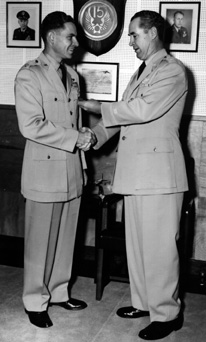The Story Of One Of The 91st SRS COs.
|
|||||||||
| After being reunited with my family in Vacaville, we moved to Riverside, bought a home. Son Gary was in grade school and daughter Terry a toddler capable of getting into trouble on a moment’s notice. I spent the next three years on the Operations staff of 15th AF as Deputy Director of Training in the Operations Directorate. Memorable during the next three years was a hand in developing the training program at Castle AFB, Atwater, CA for the B-52s, the gradual phase out of the B-36s and RB-36s, a trip to New Zealand and Australia to recommend whether or not to map Antarctica with RB-36s. Our team recommended against it for a number of cogent reasons.
I was also directly involved in the decision on what to do with the FICON program. (The term FICON stood for “Fighter-Conveyor” and referred to modified RF-84s [RF-84K) suspended, launched and retrieved from B-36s.) SAC had one squadron of RF-84K fighter-bombers at Larson AFB, WA especially equipped with a device to hook onto a trapeze extended from an RB-36 bomb bay. |
|||||||||
 |
|||||||||
|
|
|||||||||
|
Photo ctsy F. Ferrer Collection Below: Hooking Up — Photo ctsy F. Ferrer Collection |
|||||||||
|
One squadron of RB-36s based at Fairchild AFB, WA was equipped with a bomb bay trapeze modification that in the up position enabled the RB-36 to carry the RF-84K in the bomb bay. The pilot could exit the fighter-bomber into a pressurized cabin of the RB-36 until time to launch. A very large pit about the size of an olympic swimming pool was dug into the Fairchild parking apron. The RF-84K would be towed into the pit, the RB-36 above it and the fighter bomber pulled up into the bay via the trapeze. It would be launched off the Russian coast, fly to its assigned target, drop its bomb and be recovered back into the RB-36. The project was two years behind schedule. Had it been on schedule, it would have made a relatively small addition to SAC’s total war plan capabilities. Also, the rest of the RB-36s and B-36s at Fairchild were, by this time, starting their conversion to B-52s. There were problems in recovering onto the trapeze. A down draft occurred just as the fighter pilot was about to hook onto the trapeze resulting in the need to add power. This often resulted in damage to the windshield of the RF-84K. Then Major General Archie Olds, 15th AF Commanding General, asked a veteran fighter pilot squadron commander, Lt. Col. Al Vivian and I to fly up to Fairchild, inspect the program and make a recommendation on what to do. We spent a few days flying alongside hookups with results as mentioned above, before returning to March AFB, The next morning, I was talking to Gen Olds’ secretary in his outer office when he heard me and asked me to come into his office. I told him that we had not yet written a report. He asked what he should do with the program and I told him to scrap it. He then said, that’s all I want to know. No report will be necessary. Thank you and also thank Lt. Col. Vivian. .
My next assignment was equally satisfying. I was loaned by SAC to NORAD (North American Air Defense Command) for three years at Ent AFB, CO. As a charter member of NORAD, I was assigned as Director of Operational Intelligence. General Partridge, who had commanded FEAF, was the first NORAD commander. He retired shortly thereafter and was replaced by General Kuter. I reported in during the summer of 1957. Sold our home in Riverside and bought a new home in Colorado Springs. Son Gary was entering Junior High School and daughter Terry in Elementary school. 1957 was the year that the Air Force Academy moved from Lowry AFB to their beautiful new campus. I asked why the Chapel at the Academy had 17 spires. I was informed that twelve of the spires were for the twelve apostles, and the other five spires for the five members of the House Appropriations Committee that funded it. A very good reason and a great joke! This was my first joint command assignment. I was blessed with a competent Navy Commander, Pat Frick for a deputy. We worked well together. I was fortunate to be promoted to full Colonel in March of 1958. Ironically, I also received orders that same day that I now held the rank of permanent Captain in the Air Force. I had been a reserve officer since commissioning. We provided the scenarios for several war game exercises as the cold war with the USSR heated up. We were also busy with the initial planning of the mission and space requirements for intelligence prior to the construction of the hardened NORAD buildings that were later to be built into Cheyenne mountain. A very interesting three years in an intelligence assignment. At the end of my tour June 30, 1960, I was assigned to SAC Headqarters, Bellevue, NE, just at the time that the Joint Strategic Target Planning Staff (JSTPS) was formed. I found myself wearing two hats. One, as Deputy Director of Targets on the SAC Intelligence staff; the other as Chief of Targets in the National Single Target List Division (NSTL). |
|||||||||
|
1 — 2 — 3 — 4 — 5 — 6 — 7 — 8 — 9 — 10 — 11 Cover Page — Introduction — Table of Contents Or you may go to Home - Contact Us - Cold War Hist. - 91st SRS Hist. - Stardust 40 Mission Story |
|||||||||